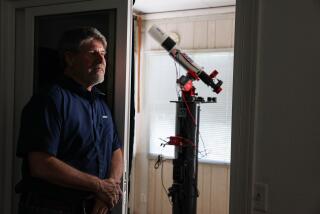Supernova traced to collision of white dwarf stars
Type 1a supernovae, exploding stars that can outshine entire galaxies, were instrumental to the Nobel Prize-winning discovery that a mysterious “dark energy” is fueling the expansion of the universe. But astronomers haven’t been able to pin down what causes these massive stellar explosions.
Now, after studying a Type 1a supernova in a nearby galaxy, two researchers say that they must be the result of a collision between two white dwarf stars. They made their case this week in the journal Nature.
Pinning down the origins of these so-called standard candles, which can be used to help determine the brightness of other objects, may aid scientists in sharpening their understanding of the nature of dark energy.
As astronomers map out the known universe, it can be hard to tell whether a tiny speck of light is from an object that is bright but far away or dim but nearby. Type 1a supernovae, on the other hand, are thought to all shine at the same peak brightness, which allows scientists to determine how far away they are.
But a Type 1a supernova isn’t as sharp a tool as it could be because astronomers still don’t understand exactly how it comes to be. Scientists also suspect that the older a supernova is, the less accurate its brightness might be because the chemistry of those early-universe stars was different.
In order for astronomers to build on the previous research and figure out what dark energy is, they need to learn more about Type 1a supernovae, said Bradley Schaefer, an astronomer at Louisiana State University in Baton Rouge and lead author of the Nature paper.
One theory about these exploding stars is that they erupt after the gravity from a white dwarf — a burned-out star usually composed of carbon and oxygen — starts pulling in matter in from an orbiting companion star. When the white dwarf reaches a critical mass — about 1.4 times the mass of our sun — it blows up. The force of the explosion might strip a layer off the companion star but leave it largely intact.
A competing theory is that Type 1a supernovae occur when two white dwarf stars that orbit each other gradually move closer together until they collide and explode, annihilating both.
If astronomers could find a companion star in the neighborhood of a recently exploded supernova, it could help settle the question.
Schaefer and graduate student Ashley Pagnotta decided to look for one in a nearby galaxy known as the Large Magellanic Cloud. They focused on one particular supernova remnant, called SNR 0509-67.5, and began making plans to observe it with a telescope.
As it turned out, that wasn’t necessary. On Jan. 25, Schaefer caught a glimpse of NASA’s “Astronomy Picture of the Day” on the Web. For a moment, he thought he’d been scooped. It was the supernova he’d been planning to study.
Thankfully for Schaefer, the researchers who took the photo had been looking at a different aspect of the supernova. But it turned out to be just what he needed — near the center of the supernova, there were no stars to be seen.
This supernova could not have been fueled by a companion star that survived; therefore, it must have been the result of two white dwarfs dancing toward their deaths, he said. And because Type 1a supernovae are all so similar, Schaefer said, it’s likely that what holds for one would hold for them all.
Just to be sure, Schaefer is looking at other Type 1a supernovae in the Large Magellanic Cloud to see whether the same pattern holds.
Until more evidence is in, however, some researchers aren’t sure the findings can be generalized.
“They’ve done a pretty accurate work” on SNR 0509-67.5, said Pilar Ruiz-Lapuente, an astrophysicist at the University of Barcelona in Spain who is conducting a similar search in our Milky Way galaxy. “But two paths can lead to the final result.”





